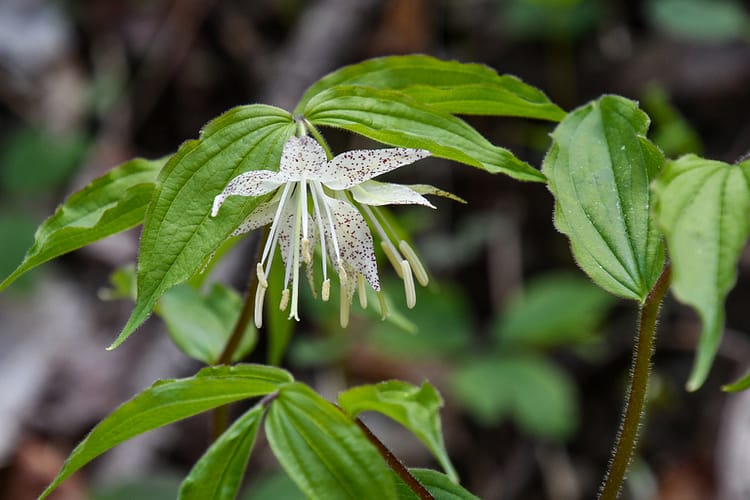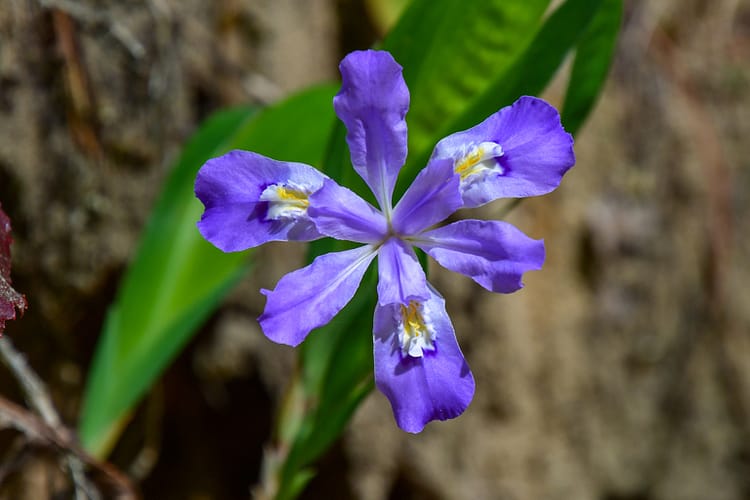Hope springs eternal is a phrase that has been in my mind this season. It was a tough winter in many ways- for all of us. The hope of spring hikes loomed large, with spring ephemerals representing the abundance and perfection of nature’s resilience, and a sumptuous prelude to summer greenery.
I continued with shorter hikes over the fall and winter. During this time, my husband Bernie underwent treatment with two different lines of chemotherapy. The first chemo regimen did nothing to stop or slow the cancer. The second line was successful, but was discontinued due to complications. Bernie is now participating in an immunotherapy clinical trial. His hope and determination is incredible, and with time, he is slowly gaining increased mobility with short hikes. Being in nature and on the trail is great therapy, both emotionally and physically.
If you hike, you quickly learn that spring ephemeral bloom times vary, depending on elevation, directional orientation, microclimates and other factors. Sometimes, due to these variations, it feels like spring is longer when you mix up hikes in different elevations. Here is a resource that lists wildflower bloom times in the Southern Appalachians: http://www.ncnatural.com/wildflwr/blmtime.html

There are two types of Mandarin, and I recently learned that mandarin, both spotted and yellow, have been moved to a different genus within the Lily family. https://uswildflowers.com/detail.php?SName=Prosartes%20maculata
Last weekend, I was on a trail with both kinds of mandarin, and it gave me the opportunity to compare them- literally side by side. Both species blend in well with the understory, and as a result, can be overlooked. Unless of course, you are a geek like me, and slow your pace to catch all the spring ephemerals!
Ashmore Heritage Preserve- Cleveland, SC
The Blue Ridge escarpment is one of those places that prolongs spring wildflower season. This year, it has been tough to catch dwarf iris in bloom, but I spotted a few of these stragglers in upstate South Carolina at the Ashmore Heritage Preserve. The first was a deep, rich violet hue, interspersed with lilac. The second dwarf iris sports pale shades of lavender, almost looking like a watercolor that fades into a deep royal purple to highlight the crests of the sepals.


Another simply gorgeous spring find is the Pinkshell azalea, which pops in texture and contrast against the dark aquamarine background of Lake Wattacoo.

Spring Ephemerals at Big Ivy- Pisgah National Forest
Jack-in-the-Pulpit is always a welcome sight, from spring to late summer and fall. The spathe- pictured here, with maroon stripes- hides berries that will mature to a bright red in late summer. The second image shows lime green and chartreuse stripes on the spathe.


I adore succulents, so seeing Stonecrop in the wild it quite fulfilling. Stonecrop shows up in all seasons, and it is gratifying to see its resilience in the winter while one is longing for spring. The mix of green and pinkish-magenta leaves and stems atop the moss- just beautiful.

An Ode to Trout Lily
Trout lily has leaves that are as unique as the flowers. It is not hard to imagine how the common name was derived when you see the mottled leaves. The flowers often have spots and striations that mimic the leaves and the stamens take on a deep burgundy color over time.





And here is the fully formed squirrel corn a few weeks later….

And the inflated, inverted Dutchman’s breeches!

Spring on the Jerry Miller Trail, Shelton Laurel backcountry

The Jerry Miller trail begins in a rich cove forest, with spring ephemerals strewn about- trillium (both large white and wakerobin), spring beauty, trout lily, hepatica, chickweed, squirrel corn, dutchman’s breeches, cutleaf toothwort, rue anemone, violets- the variety is simply astounding! Shelton Laurel & Rocky Fork: Wildflower Previews


This last image is of hepatica, and it can be identified by the unique leaves all year long. Even in the darkest of winters, hepatica leaves are a welcome reminder that the light of spring and ephemeral blooms are ahead.
I hope that you are getting out there, and seizing the hope that lies in spring and all her beautiful gifts!



2 Comments
Rip Jackson · May 25, 2021 at 1:34 am
I was lucky to be in the Pisgah national Forest for almost a month in late April and early May. One of the things I saw for the first time was a yellow Lady slipper. I had never seen that in the wild before. It was so beautiful! I will keep you and Bernie in my thoughts and I hope he continues to get better. And thank you so much for these wonderful inspiring nature blogs!
Cathy · May 25, 2021 at 1:50 am
Love to see this in my email. You are such a talented writer and photographer. I am sorry to hear Bernie and you had such a difficult winter. Please tell Bernie that when he beats the cancer, I will shave my beard off in his sink it seems only fair. Cathy LeVan Gainer
Comments are closed.